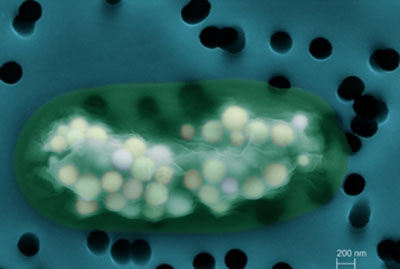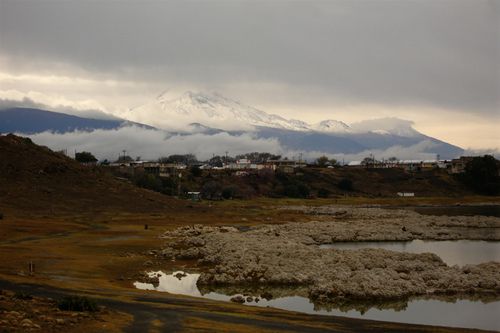Candidatus gloeomargarita lithophora: Difference between revisions
No edit summary |
No edit summary |
||
| (29 intermediate revisions by 3 users not shown) | |||
| Line 1: | Line 1: | ||
{{ | {{Moore2013}} | ||
{{Biorealm Genus}} | {{Biorealm Genus}} | ||
==Classification== | ==Classification== | ||
| Line 5: | Line 5: | ||
===Higher order taxa=== | ===Higher order taxa=== | ||
Domain (Bacteria); Phylum (Cyanobacteria); Class (Gloeobacteria); Order (Gloeobacterales); Genus (Candidatus Gloeomargarita)<sup>1</sup> | Domain (Bacteria); Phylum (Cyanobacteria); Class (Gloeobacteria); Order (Gloeobacterales); Genus (Candidatus Gloeomargarita)<sup>[1]</sup> | ||
===Species=== | ===Species=== | ||
| Line 11: | Line 11: | ||
''Candidatus Gloeomargarita lithophora'' | ''Candidatus Gloeomargarita lithophora'' | ||
[[File:Candidatus_Gloeomargarita_lithophora.jpg|thumb|500px|Magnified view of <I>Candidatus Gloeomargarita lithophora</I> and biomineralizations<sup>[2]</sup>]] | |||
==Description and significance== | ==Description and significance== | ||
<I>Candidatus | <I>Candidatus</I> Gloeomargarita lithophora, a [http://en.wikipedia.org/wiki/Cyanobacteria cyanobacterium], was found growing associated to [https://en.wikipedia.org/wiki/Stromatolite microbialites] in an alkaline lake in Mexico in 2012. This microbe control the formation of intracellular carbonate granules. <I>Ca.</I>G. lithophora is the first bacterium shown to produce internal [http://en.wikipedia.org/wiki/Biomineralization biomineralizations],<sup>[2]</sup> as opposed to some other cyanobacteria which can precipitate minerals out of the cell.<sup>[3]</sup> The ability of intracellular calcification has recently been extended to other members of the Cyanobacteria <sup>[7]</sup>. The mechanism for this biomineralization is still unknown, but it is possible that this mechanism is ancient in the cyanobacterial lineage.<sup>[2]</sup> It is hypothesized that internal mineralized granules are not likely to get preserved after the cell death, indeed these particles have never been observed outside of the cell. This observation could help explain the lack of microfossils from the early origins of cyanobacteria about 2.7 billion years ago, as evidenced by atmospheric oxygen levels, to the earliest fossil evidence of cyanobacteria about 1.2 billion years ago. <sup>[4]</sup> | ||
==Genome structure== | ==Genome structure== | ||
The genome for <I>Candidatus</I> Gloeomargarita lithophora has not yet been studied, but a related microbe, <I>Gloeobacter violaceus</I>, has a single circular chromosome with no [http://en.wikipedia.org/wiki/Plasmid plasmid].<sup>[5]</sup> Notably, the species <I>Gloeobacter violaceus</I> is lacking [https://en.wikipedia.org/wiki/Thylakoid thylakoid membranes]. | |||
==Cell and colony structure== | ==Cell and colony structure== | ||
<I>Candidatus | <I>Candidatus</I> Gloeomargarita lithophora is a rod-shaped, unicellular microbe measuring about 4 μm long and 1 μm wide. These cells contain around 20 spherical granules within the cytoplasm, each measuring about 270 nm in diameter; these granules comprise roughly 6% of the cell's volume and increase the density of the cell by 12%.This species is also capable of forming [http://en.wikipedia.org/wiki/Biofilm biofilms]<sup>[2]</sup> | ||
[[File:Lake_alchichica.jpeg|thumb|500px|Lake Alchichica, Mexico.<sup>[6]</sup>]] | |||
==Metabolism== | ==Metabolism== | ||
<I> Candidatus | As every Cyanobacteria, <I> Candidatus</I> Gloeomargarita lithophora uses light as an energy source to perform carbon fixation. A proton gradient forms along the plasma membrane, where [http://en.wikipedia.org/wiki/Phycobilisomes phycobilisomes], light harvesting structures, are attached to the cytoplasmic side. <I>Ca.</I>G. lithophora uses water as an electron donor and produces oxygen as a byproduct. This pathway is known as oxygenic photosynthesis <sup>[5]</sup> | ||
==Ecology== | ==Ecology== | ||
A recent survey of the Pasteur culture collection of Cyanobacteria as long as other sample sources revealed that intracellular mineralization is widespread in Cyanobacteria. Intracellular calcification is thus a more general mechanisms in Cyanobacteria than previously thought and is certainly not restricted to the geochemical conditions of the alkaline lake where <I>Ca. Gloeomargarita lithophora</I> was first described <sup>[7]</sup> | |||
== | ==Future Research== | ||
Future research on <I>Candidatus Gloeomargarita lithophora</I> may focus on the mechanisms of controlled intracellular mineralization, as well as studying its genome.<sup>[2]</sup> Another question that needs to be looked at is whether the biomineralizations disintegrate after the cell dies. If this is the case, it may help to explain a lack of fossil evidence for these types of microbes.<sup>[4]</sup> | |||
==References== | |||
[1] ["Taxonomy Browser." NCBI. U.S. National Library of Medicine, n.d. Web. 9 Mar. 2013. <http://www.ncbi.nlm.nih.gov/Taxonomy/Browser/wwwtax.cgi?mode=Info>.] | |||
[2] [Couradeau, E., Benzerara, K., Gérard, E., Moreira, D., Bernard,S., Brown Jr., G.E., and López-García, P. “An Early-Branching Microbialite Cyanobacterium Forms Intracellular Carbonates,” Science 336 (2012), 459. DOI: 10.1126/science.1216171] | |||
[3] [Power, I., Wilson, S., Thom, J., Dipple, G., and Southam, G. "Biologically Induced Mineralization of Dypingite by Cyanobacteria from an Alkaline Wetland near Atlin, British Columbia, Canada." Geochemical Transactions 8.1 (2007): 13. Print. doi:10.1186/1467-4866-8-13] | |||
[ | |||
[4] [Riding, R. "A Hard Life for Cyanobacteria." Science 336 (2012): 427. DOI: 10.1126/science.1221055] | |||
[ | [5] [Nakamura, Y., Kaneko, T., Sato, S. et al. "Complete genome structure of Gloeobacter violaceus PCC 7421, a cyanobacterium that lacks thylakoids". DNA Res. 10 (4): 137–45 (2003)DOI: 10.1093/dnares/10.4.137.] | ||
[ | [6] [ROV, Veronica. "Photos." Alchichica Lake, a Photo from Veracruz, Gulf. TrekEarth, 03 June 2007. Web. 25 Apr. 2013. http://www.trekearth.com/gallery/North_America/Mexico/Gulf/Veracruz/Perote/photo663669.htm] | ||
[ | [7] [K Benzerara, F Skouri-Panet, J Li, C Férard, M Gugger, T Laurent, E Couradeau, M Ragon, J Cosmidis, N Menguy, I Margaret-Oliver, R Tavera, P López-García, and D Moreira Intracellular Ca-carbonate biomineralization is widespread in cyanobacteria 10.1073/pnas.1403510111 PNAS July 29, 2014 vol. 111 no. 30 10933-10938] http://www.pnas.org/content/111/30/10933.abstract | ||
Edited by Andy Nichols, student of Dr. Lisa R. Moore, University of Southern Maine, Department of Biological Sciences, http://www.usm.maine.edu/bio | Edited by Andy Nichols, student of Dr. Lisa R. Moore, University of Southern Maine, Department of Biological Sciences, http://www.usm.maine.edu/bio | ||
Latest revision as of 15:16, 22 February 2016
A Microbial Biorealm page on the genus Candidatus gloeomargarita lithophora
Classification
Higher order taxa
Domain (Bacteria); Phylum (Cyanobacteria); Class (Gloeobacteria); Order (Gloeobacterales); Genus (Candidatus Gloeomargarita)[1]
Species
Species (lithophora)
Candidatus Gloeomargarita lithophora
Description and significance
Candidatus Gloeomargarita lithophora, a cyanobacterium, was found growing associated to microbialites in an alkaline lake in Mexico in 2012. This microbe control the formation of intracellular carbonate granules. Ca.G. lithophora is the first bacterium shown to produce internal biomineralizations,[2] as opposed to some other cyanobacteria which can precipitate minerals out of the cell.[3] The ability of intracellular calcification has recently been extended to other members of the Cyanobacteria [7]. The mechanism for this biomineralization is still unknown, but it is possible that this mechanism is ancient in the cyanobacterial lineage.[2] It is hypothesized that internal mineralized granules are not likely to get preserved after the cell death, indeed these particles have never been observed outside of the cell. This observation could help explain the lack of microfossils from the early origins of cyanobacteria about 2.7 billion years ago, as evidenced by atmospheric oxygen levels, to the earliest fossil evidence of cyanobacteria about 1.2 billion years ago. [4]
Genome structure
The genome for Candidatus Gloeomargarita lithophora has not yet been studied, but a related microbe, Gloeobacter violaceus, has a single circular chromosome with no plasmid.[5] Notably, the species Gloeobacter violaceus is lacking thylakoid membranes.
Cell and colony structure
Candidatus Gloeomargarita lithophora is a rod-shaped, unicellular microbe measuring about 4 μm long and 1 μm wide. These cells contain around 20 spherical granules within the cytoplasm, each measuring about 270 nm in diameter; these granules comprise roughly 6% of the cell's volume and increase the density of the cell by 12%.This species is also capable of forming biofilms[2]
Metabolism
As every Cyanobacteria, Candidatus Gloeomargarita lithophora uses light as an energy source to perform carbon fixation. A proton gradient forms along the plasma membrane, where phycobilisomes, light harvesting structures, are attached to the cytoplasmic side. Ca.G. lithophora uses water as an electron donor and produces oxygen as a byproduct. This pathway is known as oxygenic photosynthesis [5]
Ecology
A recent survey of the Pasteur culture collection of Cyanobacteria as long as other sample sources revealed that intracellular mineralization is widespread in Cyanobacteria. Intracellular calcification is thus a more general mechanisms in Cyanobacteria than previously thought and is certainly not restricted to the geochemical conditions of the alkaline lake where Ca. Gloeomargarita lithophora was first described [7]
Future Research
Future research on Candidatus Gloeomargarita lithophora may focus on the mechanisms of controlled intracellular mineralization, as well as studying its genome.[2] Another question that needs to be looked at is whether the biomineralizations disintegrate after the cell dies. If this is the case, it may help to explain a lack of fossil evidence for these types of microbes.[4]
References
[1] ["Taxonomy Browser." NCBI. U.S. National Library of Medicine, n.d. Web. 9 Mar. 2013. <http://www.ncbi.nlm.nih.gov/Taxonomy/Browser/wwwtax.cgi?mode=Info>.]
[2] [Couradeau, E., Benzerara, K., Gérard, E., Moreira, D., Bernard,S., Brown Jr., G.E., and López-García, P. “An Early-Branching Microbialite Cyanobacterium Forms Intracellular Carbonates,” Science 336 (2012), 459. DOI: 10.1126/science.1216171]
[3] [Power, I., Wilson, S., Thom, J., Dipple, G., and Southam, G. "Biologically Induced Mineralization of Dypingite by Cyanobacteria from an Alkaline Wetland near Atlin, British Columbia, Canada." Geochemical Transactions 8.1 (2007): 13. Print. doi:10.1186/1467-4866-8-13]
[4] [Riding, R. "A Hard Life for Cyanobacteria." Science 336 (2012): 427. DOI: 10.1126/science.1221055]
[5] [Nakamura, Y., Kaneko, T., Sato, S. et al. "Complete genome structure of Gloeobacter violaceus PCC 7421, a cyanobacterium that lacks thylakoids". DNA Res. 10 (4): 137–45 (2003)DOI: 10.1093/dnares/10.4.137.]
[6] [ROV, Veronica. "Photos." Alchichica Lake, a Photo from Veracruz, Gulf. TrekEarth, 03 June 2007. Web. 25 Apr. 2013. http://www.trekearth.com/gallery/North_America/Mexico/Gulf/Veracruz/Perote/photo663669.htm]
[7] [K Benzerara, F Skouri-Panet, J Li, C Férard, M Gugger, T Laurent, E Couradeau, M Ragon, J Cosmidis, N Menguy, I Margaret-Oliver, R Tavera, P López-García, and D Moreira Intracellular Ca-carbonate biomineralization is widespread in cyanobacteria 10.1073/pnas.1403510111 PNAS July 29, 2014 vol. 111 no. 30 10933-10938] http://www.pnas.org/content/111/30/10933.abstract
Edited by Andy Nichols, student of Dr. Lisa R. Moore, University of Southern Maine, Department of Biological Sciences, http://www.usm.maine.edu/bio


